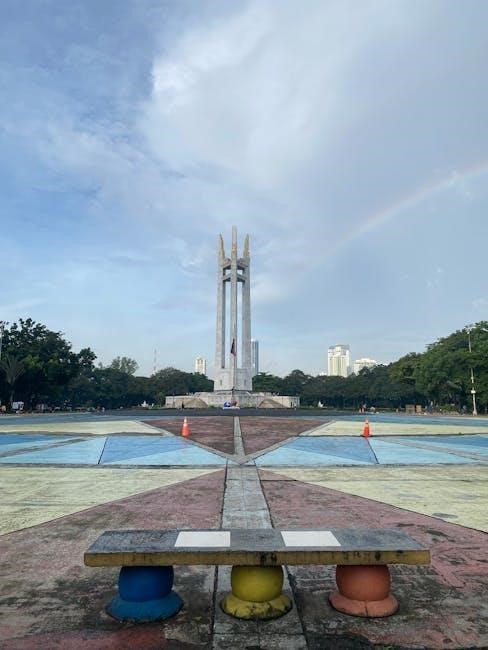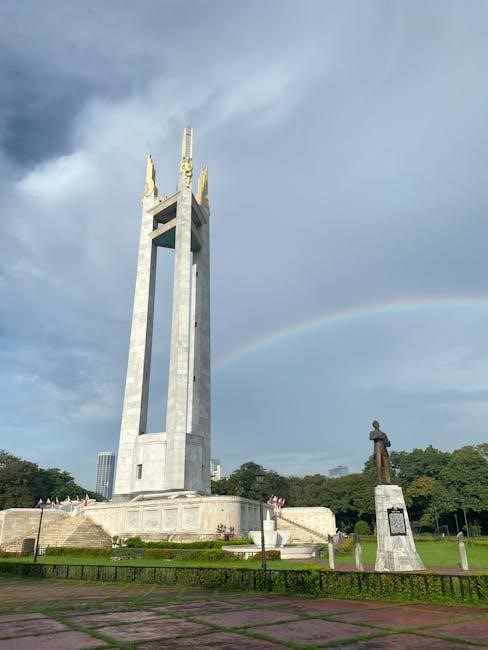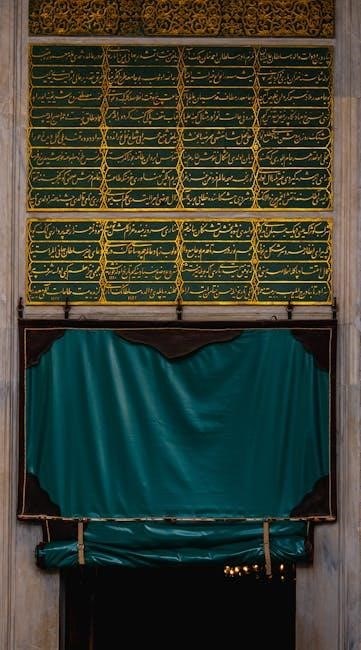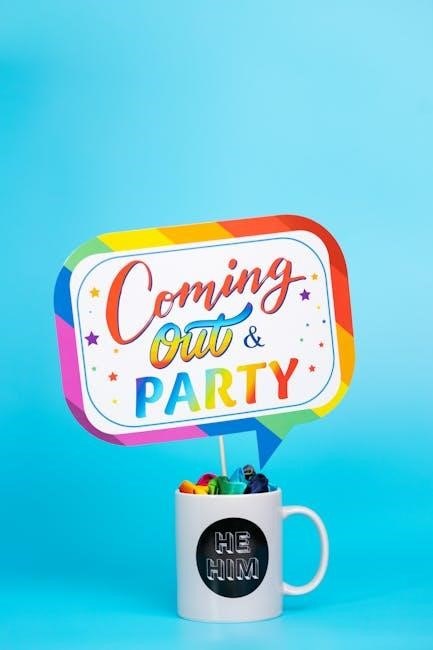“When the Rainbow is Enuf” is a groundbreaking play by Ntozake Shange‚ first performed in 1975‚ exploring themes of identity‚ sisterhood‚ and resilience through interconnected stories of seven women navigating oppression in a racist and sexist society.
1.1. Background of the Play
“When the Rainbow is Enuf”‚ written by Ntozake Shange in 1975‚ is a groundbreaking choreopoem that blends poetry‚ dance‚ and music to explore the lives of Black women. The play follows seven female characters‚ each representing a different aspect of Black womanhood‚ as they navigate racism‚ sexism‚ and personal struggles. Premiering Off-Broadway‚ it became a critical and cultural phenomenon‚ challenging traditional theatrical forms and amplifying voices often marginalized. Shange’s innovative use of African American Vernacular English and poetic dialogue created a powerful narrative that resonated deeply. The script‚ available in PDF formats for study‚ remains a vital work in American theater‚ offering insights into identity‚ sisterhood‚ and resilience. Its impact endures as a testament to the strength of Black women’s experiences.
1.2. Historical Context of the Script
“When the Rainbow is Enuf”‚ written by Ntozake Shange‚ emerged during the 1970s‚ a period marked by heightened social and political activism. The play reflects the struggles of Black women navigating racism‚ sexism‚ and economic inequality during this era. It was a time when the civil rights and feminist movements were gaining momentum‚ yet Black women often found themselves marginalized within these movements. Shange’s work became a powerful voice for these women‚ offering a raw and unfiltered portrayal of their lives. The script‚ available in PDF formats‚ captures the essence of this historical moment‚ blending personal narratives with broader societal issues. Its release in 1975 coincided with a growing demand for diverse storytelling‚ making it a landmark work in American theater and a testament to the resilience of Black women.

Themes and Messages in the Play
“When the Rainbow is Enuf” explores themes of sisterhood‚ identity‚ and resilience‚ highlighting the struggles of Black women in a racist and sexist society through poetic language and powerful narratives.
2.1. Exploration of Sisterhood and Female Empowerment
“When the Rainbow is Enuf” profoundly explores sisterhood and female empowerment‚ portraying the interconnected lives of seven Black women navigating racism‚ sexism‚ and personal struggles. Through their shared experiences‚ the play highlights the strength found in solidarity and mutual support. Each character embodies resilience‚ challenging societal norms while fostering a sense of community. The script emphasizes how these women‚ though individually unique‚ collectively rise above oppression‚ celebrating their identities and reclaiming their voices. Shange’s use of poetic dialogue and vivid storytelling underscores the transformative power of sisterhood‚ making it a cornerstone of the play’s message. This exploration remains a powerful testament to the enduring spirit of women in the face of adversity.
2.2. Themes of Identity and Resilience
“When the Rainbow is Enuf” delves into the themes of identity and resilience‚ portraying the struggles of seven Black women navigating a society marked by racism and sexism. Each character grapples with their sense of self‚ confronting internal and external pressures that threaten their autonomy. Through poetic dialogue and raw storytelling‚ the play captures the women’s journeys of self-discovery and their ability to endure despite systemic oppression. The script highlights their resilience as they find strength in their cultural heritage and personal experiences‚ ultimately affirming their identities and challenging societal norms. Shange’s exploration of these themes underscores the universal struggle for self-definition and the unyielding spirit of women in the face of adversity‚ making the play a powerful commentary on identity and survival.

Character Analysis
The characters in When the Rainbow is Enuf are vibrant archetypes‚ each embodying unique facets of Black female experience‚ united by resilience and the exploration of identity.
3.1. The Seven Women: Their Roles and Significance
The seven women in When the Rainbow is Enuf represent diverse aspects of Black female life‚ each embodying unique struggles and triumphs. They are interconnected yet distinct‚ symbolizing the universality of their experiences. From the youthful energy of one to the wisdom of another‚ their stories weave together to create a tapestry of resilience and strength. These characters are not just individuals but archetypes‚ reflecting the broader societal challenges faced by Black women. Their roles highlight themes of identity‚ sisterhood‚ and survival‚ making them central to the play’s exploration of empowerment and liberation. Each woman’s voice adds depth‚ enriching the narrative and underscoring the collective struggle for equality and justice.
3.2. Interconnected Stories and Narratives
The play interweaves the stories of seven Black women‚ creating a mosaic of experiences that reflect their shared struggles and triumphs. While each character’s narrative is distinct‚ they are deeply interconnected‚ highlighting the universality of their journeys. The script’s non-linear structure allows these stories to flow into one another‚ mirroring the cyclical nature of life and the collective memory of Black women. This interconnectedness emphasizes the idea that individual struggles are part of a larger communal experience. Through their shared narratives‚ the play underscores themes of unity‚ resilience‚ and the strength found in shared identity. The absence of a traditional plot structure reinforces the idea that their stories are part of a continuous‚ evolving tapestry of Black female life.

Script Structure and Format
The script’s unique structure blends poetry and prose‚ creating a non-linear narrative. Episodic scenes and dialogue reflect the characters’ fragmented yet interconnected experiences‚ emphasizing themes of resilience and unity.
4.1. Unique Narrative Style and Dialogue
The script employs a unique narrative style‚ blending poetry and prose to create a lyrical yet raw depiction of Black women’s lives. The dialogue is expressive and rhythmic‚ reflecting the characters’ emotional depth and cultural richness. Each scene is episodic‚ with interconnected vignettes that explore themes of identity and resilience. The use of African American Vernacular English adds authenticity‚ while poetic language elevates the storytelling. This hybrid style allows the play to transcend traditional drama‚ becoming a powerful exploration of collective and individual experiences. The structure emphasizes the interconnectedness of the women’s stories‚ creating a seamless flow that resonates deeply with audiences.
4.2. Use of Poetry and Prose in the Script
The interplay of poetry and prose in When the Rainbow is Enuf creates a vibrant and expressive narrative. Shange masterfully blends poetic language with prose‚ allowing the script to flow rhythmically while maintaining emotional intensity. Poetry is used to highlight the inner thoughts and feelings of the characters‚ adding depth and universality to their experiences. Prose‚ on the other hand‚ grounds the story in realism‚ making the struggles and triumphs of the women relatable. This dual approach enhances the play’s emotional resonance‚ offering both lyrical beauty and raw authenticity. The fusion of these literary forms underscores the richness of African American culture and language‚ making the script a powerful exploration of identity and resilience.

Symbolism in the Play
The play uses vivid symbols to convey themes of hope and resilience. Imagery and colors represent unity and the struggle for liberation‚ enriching the narrative deeply.
5.1. The Rainbow as a Central Symbol
The rainbow in for colored girls who have considered suicide/when the rainbow is enuf is a powerful symbol of hope‚ unity‚ and transformation. It represents the promise of a better future and the resilience of women of color. The rainbow’s vibrant colors signify the diversity and richness of their experiences‚ while its arc suggests a journey from darkness to light. Shange uses the rainbow as a metaphor for collective strength‚ implying that when women come together‚ they can overcome oppression. The title itself‚ playing on the idea of “enough‚” highlights the rainbow as a symbol of sufficiency and empowerment‚ reminding the characters—and the audience—that their struggles are valid and their survival is a testament to their enduring spirit.
5.2. Significance of Colors and Imagery
In for colored girls who have considered suicide/when the rainbow is enuf‚ colors and imagery are deeply intertwined with the emotional and psychological journeys of the characters. Each color—such as red‚ yellow‚ and brown—carries specific symbolic meanings‚ reflecting the women’s inner worlds and collective experiences. The imagery of nature‚ particularly the earth and flowers‚ evokes themes of growth‚ renewal‚ and resilience. These visual elements are not just aesthetic but serve as a language that transcends words‚ connecting the audience to the characters’ pain‚ joy‚ and liberation. The interplay of colors and imagery creates a vivid tapestry‚ amplifying the play’s emotional depth and reinforcing its themes of identity‚ sisterhood‚ and survival.

Stage Directions and Performance Notes
The play’s stage directions emphasize fluid movement and expressive choreography‚ enhancing the emotional narrative. Minimalistic props and symbolic sets create a powerful‚ evocative atmosphere‚ guiding performers and audience alike.
6.1. Choreography and Movement in the Play
The choreography in When the Rainbow is Enuf is deeply intertwined with the narrative‚ using movement to convey the emotional journeys of the characters. The script specifies fluid‚ expressive dance sequences that reflect the women’s struggles and triumphs. Movement is not merely decorative but serves to amplify the storytelling‚ creating a bridge between dialogue and emotion. The choreography often incorporates African American cultural traditions‚ adding layers of authenticity and resonance. Performers are encouraged to use their bodies to express vulnerability‚ strength‚ and unity‚ making the physicality of the play a powerful tool for connecting with the audience on a visceral level. This integration of movement underscores the play’s themes of resilience and sisterhood.
6.2. Music and Sound Integration
Music and sound play a pivotal role in When the Rainbow is Enuf‚ enhancing the emotional depth and cultural resonance of the play. The script incorporates traditional African American music‚ including blues‚ jazz‚ and spirituals‚ to reflect the characters’ experiences and heritage. Sound effects‚ such as ambient noises and rhythmic beats‚ are used to set the scene and evoke the gritty urban environment. The integration of music serves to bridge dialogue and action‚ creating a dynamic interplay between sound and movement. The play’s score is deeply tied to its themes of identity and liberation‚ with songs often functioning as a form of resistance and empowerment. This auditory dimension enriches the narrative‚ making the performance a multisensory experience that resonates deeply with audiences.

Themes of Oppression and Liberation
The play portrays oppression through societal ills like racism and sexism‚ while liberation emerges through sisterhood‚ resilience‚ and self-discovery‚ highlighting the strength of African American women.
7.1. Racism and Sexism in the Play
Racism and sexism are central themes in When the Rainbow is Enuf‚ as the characters navigate a society that marginalizes them based on race and gender. The play vividly portrays the systemic oppression faced by African American women‚ highlighting the intersectionality of these injustices; Through dialogue and poetic language‚ Shange illustrates the psychological and emotional toll of racism‚ from internalized self-doubt to overt discrimination. Sexism is also explored‚ as the women confront patriarchal norms that silence and demean them. The script uses raw‚ unflinching narratives to expose these injustices‚ emphasizing the resilience required to survive in a world stacked against them. The women’s stories are not just individual struggles but collective testimonies of resistance and defiance. The play’s unapologetic portrayal of these issues underscores their enduring relevance today.
7.2. The Fight for Equality and Justice
The fight for equality and justice is a powerful thread woven throughout When the Rainbow is Enuf. The play highlights the collective struggle of African American women to challenge systemic racism and sexism‚ emphasizing their resilience and determination. Through their stories‚ Shange illustrates the ways in which these women confront oppressive structures‚ seeking liberation and dignity. The script underscores the importance of unity and solidarity in the face of injustice‚ as the characters support one another in their journeys toward empowerment. The play’s depiction of their struggles and triumphs serves as a testament to the enduring fight for equality and justice‚ resonating deeply with audiences today. Its unflinching portrayal of resistance and hope continues to inspire and challenge societal norms. The legacy of this struggle remains a vital part of the play’s message.

Literary Devices and Style
The play blends poetic prose with African American Vernacular English‚ creating a rhythmic‚ emotive narrative that reflects the characters’ rich cultural and personal experiences.
8.1. Use of African American Vernacular English
The play incorporates African American Vernacular English (AAVE) to authentically portray the voices and experiences of Black women. This linguistic choice emphasizes cultural identity and fosters a sense of community‚ while also challenging stereotypes. The dialogue reflects the rhythm and cadence of spoken AAVE‚ creating a vivid and relatable narrative. By using this dialect‚ the playwright honors the unique linguistic traditions of African American culture‚ ensuring that the characters’ voices remain raw‚ genuine‚ and deeply personal. The use of AAVE also serves as a form of resistance‚ reclaiming and celebrating Black language in a society that often marginalizes it. This linguistic style is central to the play’s emotional depth and cultural resonance.
8.2. Poetic Language and Rhythmic Dialogue
The script employs poetic language and rhythmic dialogue to evoke emotions and convey deeper themes. The playwright uses metaphors‚ similes‚ and lyrical expressions to paint vivid images of the characters’ lives. The dialogue often follows a musical cadence‚ mirroring the natural flow of conversation while enhancing the dramatic impact. This blending of poetry and prose creates a unique storytelling style‚ making the narrative both accessible and profound. The rhythmic quality of the dialogue also underscores the resilience and strength of the characters‚ aligning with the play’s themes of empowerment and survival. This fusion of poetic and conversational language enriches the script‚ making it a powerful tool for both performance and literary analysis.

Relevance of the Play Today
The play remains relevant today‚ addressing timeless themes of identity‚ resilience‚ and social justice. Its exploration of sisterhood and oppression continues to resonate with modern audiences‚ offering a powerful lens through which to examine contemporary challenges and struggles for equality.
9.1. Continued Importance of Its Themes
The themes of When the Rainbow is Enuf remain profoundly relevant today‚ as they address universal struggles such as identity‚ resilience‚ and the pursuit of equality. The play’s exploration of sisterhood and female empowerment continues to resonate‚ particularly in the context of modern feminist movements and discussions about intersectionality. Its portrayal of Black women navigating systemic oppression and personal challenges offers a powerful lens through which to examine contemporary issues like racism‚ sexism‚ and economic disparity. The script’s emphasis on unity and collective strength also aligns with current social justice movements‚ making it a vital tool for fostering dialogue and understanding. Its timeless messages ensure that the play remains a cornerstone of conversations about race‚ gender‚ and empowerment‚ inspiring new generations to reflect and act.
9.2. Modern Interpretations and Adaptations

Modern interpretations of When the Rainbow is Enuf highlight its adaptability to contemporary stages and audiences. Directors often infuse the play with innovative choreography‚ blending traditional and modern dance to emphasize themes of resilience. The integration of multimedia elements‚ such as projections and original music‚ enhances the emotional depth of the narrative. Recent adaptations have also focused on amplifying the voices of the seven women‚ drawing parallels to current social justice movements. Colleges and community theaters frequently stage the play‚ introducing it to new generations. These reinterpretations not only honor the original script but also expand its relevance‚ ensuring its continued impact in addressing issues of race‚ gender‚ and identity. The play’s versatility underscores its enduring appeal and cultural significance.
When the Rainbow is Enuf remains a powerful exploration of African American women’s experiences‚ offering timeless lessons on resilience‚ sisterhood‚ and liberation. Its enduring relevance ensures continued resonance‚ inspiring future generations to embrace their identities and fight for justice.
10.1. The Enduring Legacy of “When the Rainbow is Enuf”
When the Rainbow is Enuf has left an indelible mark on African American literature and theater. Its unflinching portrayal of Black women’s lives has inspired countless adaptations and discussions. The play’s exploration of identity‚ resilience‚ and sisterhood continues to resonate‚ making it a cornerstone of feminist and racial justice dialogues. Its influence extends beyond the stage‚ shaping conversations about representation and empowerment. As a seminal work‚ it remains a powerful tool for educating audiences about the struggles and triumphs of Black women. The script’s availability in PDF format has further cemented its accessibility‚ ensuring its legacy endures for future generations. Its impact is undeniable‚ solidifying its place as a cultural and literary milestone.
10.2. Final Thoughts on the Play’s Impact
When the Rainbow is Enuf leaves a profound and lasting impact‚ transcending its original context to resonate with contemporary audiences. Its unflinching portrayal of Black women’s lives challenges societal norms and fosters dialogue about race‚ gender‚ and identity. The play’s emotional and intellectual depth ensures its relevance‚ making it a vital tool for education and reflection. The availability of the script in PDF format has widened its reach‚ allowing new generations to engage with its powerful themes. As a work of art and activism‚ it continues to inspire‚ reminding us of the strength and resilience of Black women. Its impact is not just theatrical but deeply cultural‚ cementing its place as a defining work in African American literature and theater.
